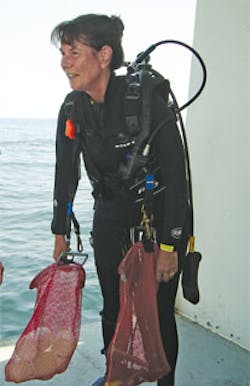Some people perform their jobs within the confines of four walls. Nancy Rabalais’s job sometimes finds her on a research vessel, where her workspace is the Gulf of Mexico. There, Rabalais gets a fish-eye view of conditions she needs to observe to report what often is bad–albeit important–news: Parts of the Gulf are in hypoxia; the areas are called the “dead zone.”
Rabalais, a professor and executive director for the Louisiana Universities Marine Consortium (LUMCON), is internationally known for her research on the dynamics of hypoxic environments and interactions of the Mississippi River with the Gulf of Mexico. LUMCON’s mission is to increase awareness of the environmental, economic, and cultural value of Louisiana’s coastal and marine environments through research and education programs focused on the state’s marine science and coastal resources needs. LUMCON staff members also conduct university classes.
In her 2014 Gulf hypoxia report, Rabalais points out that the dead zone is the size of Connecticut. Low oxygen conditions in the bottom waters of the northern Gulf of Mexico continental shelf threaten fi sh, shrimp, and crabs. Mississippi River watershed nutrients–particularly nitrogen and phosphorus–fertilize the surface waters to create excessive amounts of algal biomass, whose decomposition in the bottom layer leads to oxygen distress and organism death. Rabalais also studies estuarine and coastal eutrophication, benthic ecology, environmental effects of habitat alterations and contaminants, coastal observing systems, phytoplankton taxonomy, ecology and physiology, and the effects of the B.P. Deepwater Horizon oil spill. She chairs the National Sea Grant Advisory Board, is a trustee for the Consortium on Ocean Leadership, and serves as president of the Southern Association of Marine Labs and president-elect of the National Association of Marine Labs, and a is a board member of the Gulf of Mexico Coastal Ocean Observing System–Regional Association. Rabalais has served on several national research committees, including one that assessed ecosystem service in the Gulf of Mexico in the aftermath of the Deepwater Horizon oil spill. She is a fellow with the American Association for the Advancement of Science and the Aldo Leopold Leadership Program. She’s an Estuarine Research Federation past president, a national associate of the National Academies of Science, and past chair of the Ocean Studies Board of the National Research Council, National Academy of Science. Her work has earned recognition: a MacArthur Foundation Award, a Heinz Award, the Woods Hole Oceanographic Institution’s 2002 Bostwick H. Ketchum Award, the Blasker Award for Environmental Science and Engineering (shared with Dr. Gene Turner), the Association for the Sciences of Limnology and Oceanography’s Ruth Patrick Award, the Clarke Prize, a NOAA Environmental Hero Award, a Gulf Guardian Award, and a Clean Water Act Hero.
What She Does Day to Day
Rabalais’s days are a mix of fi eld research that includes the Gulf of Mexico hypoxia and the effects of the Deepwater Horizon oil spill in coastal and continental shelf environments. She’s also engaged in analyzing data, preparing publications, managing the research team, writing proposals, reviewing manuscripts, and carrying out her duties as executive director of LUMCON, overseeing its employees, activities, and facilities.
What Led Her to This Line of Work
Rabalais says she fell in love with biology in junior high school, a passion that continued through high school. She added the marine aspect in college. She earned a B.S. and an M.S. in biology from Texas A & I University. Her fi rst job after earning her master’s degree was a naturalist at the Padre Island National Seashore off of the coast of south Texas, then on to what is now known as the University of Texas Marine Science Institute as a research assistant/associate. She returned to school to get a Ph.D. in zoology and then went on to LUMCON.
What She Likes Best About Her Work
“I enjoy the discovery of new interactions among organisms and their environments, the whole process of integrating ecosystem science, and taking the information from the science to the public,” says Rabalais.



